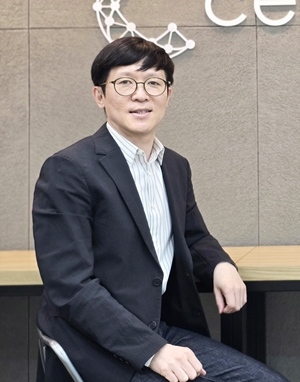- Global expansion in sight for organoid leader CellArtgen
- by Whang, byung-woo | translator Alice Kang | May 28, 2025 05:58am
With the field of organoids gaining attention, the activities of CellArtgen, which was founded by Cho Seung-woo, a leading expert in the field and professor at Yonsei University's Department of Biotechnology, have also been drawing attention.
Based on its core platform technology patents, the company has been expanding its presence by building advanced drug evaluation platforms, including the organoid disease platform 'ORANOSCREEN.’

CellArtgen was founded by Seung-Woo Cho, one of the world's leading experts in advanced biomaterials and organoid technology. As the company was established with an academic foundation, the company's strong point lies in its extensive portfolio of proprietary technologies. Dailypharm met with CellArtgen (a member of the KoreaBIO) to discuss the company's vision and strategy.
The technical strengths of the CellArtgen organoid platform lie in the integration of “extracellular matrix (ECM)-based microenvironment creation technology” and “microfluidics chip technology.”
Cho explained, “We remove cells from tissues or organs and introduce the remaining ECM into organoid culture. By using organ-specific ECM, we create an environment similar to actual organs, thereby enhancing the performance of organoids.”
For example, to create heart organoids, the ECM matrix obtained from decellularized hearts is used to produce organoid models that not only include tissue-specific cellular components but also recapitulate the inherent microenvironment, including immune cells and vascular cells, on a standardized platform with high efficiency.
In particular, CellArtgen highlights its “multi-organoids-on-a-chip” technology, which connects organoids from multiple organs onto a single chip to mimic the human body's digestive, respiratory, and nervous systems.
Cho stated, “When direct interaction between organoids is required, we apply ‘assembloids,’ which combine different organoids. The fact that we have independently secured ECM materials, organ chips, and multi-organ integration technology and integrated them into a single platform is the differentiating factor of CellArtgen’s technology.”
FDA regulatory changes… organoid technology gains attention
The company has been gradually increasing sales and expanding its customer portfolio based on its proprietary technology.
Last year, the first year of commercializing its technology, CellArtgen achieved sales of KRW 200 million, and this year, it expects sales of approximately KRW 3 billion by combining ECM products and organoid-based drug evaluation services.
The market environment is also becoming more favorable for CellArtgen. The U.S. Food and Drug Administration (FDA) removed the mandatory animal testing requirement for new drug approvals at the end of 2022 and officially announced its plan to phase out animal testing last month, signaling changes in the new drug evaluation system.
According to Cho, in addition to the long-term regulatory changes, the overall sentiment of pharmaceutical companies is also changing.
He mentioned, “Pharmaceutical companies are showing more interest in organoid technology than before, and there is a growing movement on its practical use in the industry. The change in the atmosphere is palpable.”
Cho believes that changes may occur faster than expected, particularly because global pharmaceutical companies are taking more proactive steps than large Korean pharmaceutical companies.
Cho added, “Major pharmaceutical companies in the US and Europe have already made significant preparations, such as acquiring organoid companies and recruiting experts to form dedicated teams. While domestic pharmaceutical companies are still observing the situation, CellArtgen is striving to secure a leading position in line with global trends.”
He also noted that the extent to which CellArtgen, which is still a bioventure, can accumulate successful cases will serve as a benchmark for its strategy to survive the global competition.
In this regard, CellArtgen has already begun providing organoid model services for difficult-to-treat diseases such as MASH (metabolic dysfunction-associated steatohepatitis) and IPF (idiopathic pulmonary fibrosis) to domestic pharmaceutical companies, accumulating initial results.
Cho emphasized, “Some of the major domestic pharmaceutical companies that have utilized our services have expressed satisfaction to the extent that they have requested CellArtgen’s organoid experiment services again, and are currently preparing to forge long-term partnerships. Since the service was launched less than a year ago, we have not yet accumulated many cases, but we plan to thoroughly accumulate domestic cases by the first half of next year and then begin full-scale cooperation with overseas big pharmas.”
Two-track strategy of diversifying business for revenue while targeting IPO by 2027
However, while organoid services for new drug development have significant long-term potential, the company also faces the limitation of being difficult to generate substantial revenue in the short term.
In response, CellArtgen has adopted a realistic strategy. The company has chosen to commercialize ECM materials, with a particular focus on expanding into the cosmetics and medical device sectors.
Cho explained, “While the company's ECM technology was originally developed for organoid culture, we identified its potential to achieve a certain level of regenerative therapy effects without cells and applied it to products for wound treatment and cosmetic purposes. For example, skin ECM can be used as a wound treatment agent or in cosmetics or as skin boosters, while cartilage ECM can be utilized as a cartilage filler or a treatment material for osteoarthritis.”
In other words, the company is pursuing a two-track strategy to simultaneously achieve short-term revenue and technological validation by applying ECM-based materials developed for organoid culture to wound dressings (wound treatments) and skin beauty injections.
While CellArtgen’s moves might seem like a bio-venture's foray into unfamiliar territory, the company is attracting attention for its technology, as evidenced by active discussions on development partnerships with major and mid-sized domestic pharmaceutical and biotech companies.
First, the company launched its ECM-based cosmetic brand, Cellumé, in the first half of the year and is currently collaborating with the cosmetics industry.
Cho stated, “A major domestic cosmetics ODM company has also taken notice of CellArtgen’s ECM raw material technology, conducted sample tests, and is currently requesting product supply. Additionally, we have been selected as the finalist in an open innovation competition hosted by a top-tier domestic medical device company and have begun discussions on joint development of next-generation medical devices utilizing ECM.”
CellArtgen is pursuing a business strategy centered on collaboration. After demonstrating potential through the launch of its own brand, the company is placing emphasis on open innovation by partnering with capable companies.
In the medical device sector, the company is actively utilizing external projects while continuing its development. CellArtgen aims to commercialize an ECM-based Class 2 wound dressing by the end of this year and then a Class 4 cartilage regeneration filler through government projects to launch it in 2027 after clinical trials.
With its dual focus on organoid services and ECM-applied products, CellArtgen plans to pursue an IPO on the KOSDAQ market around 2027.
The company aims to achieve sales of approximately KRW 3 billion this year, followed by KRW 5 billion in 2026, KRW 11 billion in 2027, and then KRW 50 billion by 2030. More than half of this is expected to come from sales of the aforementioned ECM cosmetics and wound dressings.
However, while securing short-term sales and attracting investment is important, the company plans to maintain its identity as a regenerative therapy company based on its organoid platform technology, which is the company’s foundational technology that could revolutionize the paradigm of new drug development.
Cho added, “We believe that CellArtgen’s organoid model has global competitiveness in areas such as antifibrotic therapy and metabolic diseases, and our goal is to replace animal testing and become a game-changer in the regenerative medicine field. We have a roadmap aimed at developing regenerative therapies for intractable liver diseases.”
-

- 0
댓글 운영방식은
댓글은 실명게재와 익명게재 방식이 있으며, 실명은 이름과 아이디가 노출됩니다. 익명은 필명으로 등록 가능하며, 대댓글은 익명으로 등록 가능합니다.
댓글 노출방식은
댓글 명예자문위원(팜-코니언-필기모양 아이콘)으로 위촉된 데일리팜 회원의 댓글은 ‘게시판형 보기’와 ’펼쳐보기형’ 리스트에서 항상 최상단에 노출됩니다. 새로운 댓글을 올리는 일반회원은 ‘게시판형’과 ‘펼쳐보기형’ 모두 팜코니언 회원이 쓴 댓글의 하단에 실시간 노출됩니다.
댓글의 삭제 기준은
다음의 경우 사전 통보없이 삭제하고 아이디 이용정지 또는 영구 가입제한이 될 수도 있습니다.
-
저작권·인격권 등 타인의 권리를 침해하는 경우
상용 프로그램의 등록과 게재, 배포를 안내하는 게시물
타인 또는 제3자의 저작권 및 기타 권리를 침해한 내용을 담은 게시물
-
근거 없는 비방·명예를 훼손하는 게시물
특정 이용자 및 개인에 대한 인신 공격적인 내용의 글 및 직접적인 욕설이 사용된 경우
특정 지역 및 종교간의 감정대립을 조장하는 내용
사실 확인이 안된 소문을 유포 시키는 경우
욕설과 비어, 속어를 담은 내용
정당법 및 공직선거법, 관계 법령에 저촉되는 경우(선관위 요청 시 즉시 삭제)
특정 지역이나 단체를 비하하는 경우
특정인의 명예를 훼손하여 해당인이 삭제를 요청하는 경우
특정인의 개인정보(주민등록번호, 전화, 상세주소 등)를 무단으로 게시하는 경우
타인의 ID 혹은 닉네임을 도용하는 경우
-
게시판 특성상 제한되는 내용
서비스 주제와 맞지 않는 내용의 글을 게재한 경우
동일 내용의 연속 게재 및 여러 기사에 중복 게재한 경우
부분적으로 변경하여 반복 게재하는 경우도 포함
제목과 관련 없는 내용의 게시물, 제목과 본문이 무관한 경우
돈벌기 및 직·간접 상업적 목적의 내용이 포함된 게시물
게시물 읽기 유도 등을 위해 내용과 무관한 제목을 사용한 경우
-
수사기관 등의 공식적인 요청이 있는 경우
-
기타사항
각 서비스의 필요성에 따라 미리 공지한 경우
기타 법률에 저촉되는 정보 게재를 목적으로 할 경우
기타 원만한 운영을 위해 운영자가 필요하다고 판단되는 내용
-
사실 관계 확인 후 삭제
저작권자로부터 허락받지 않은 내용을 무단 게재, 복제, 배포하는 경우
타인의 초상권을 침해하거나 개인정보를 유출하는 경우
당사에 제공한 이용자의 정보가 허위인 경우 (타인의 ID, 비밀번호 도용 등)
※이상의 내용중 일부 사항에 적용될 경우 이용약관 및 관련 법률에 의해 제재를 받으실 수도 있으며, 민·형사상 처벌을 받을 수도 있습니다.
※위에 명시되지 않은 내용이더라도 불법적인 내용으로 판단되거나 데일리팜 서비스에 바람직하지 않다고 판단되는 경우는 선 조치 이후 본 관리 기준을 수정 공시하겠습니다.
※기타 문의 사항은 데일리팜 운영자에게 연락주십시오. 메일 주소는 dailypharm@dailypharm.com입니다.
- [Reporter's View] Transparent info, the key to vaccine trust
- Reporter's view | Son, Hyung Min









